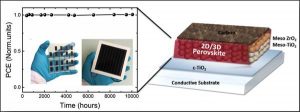[ad_1]
Perovskite solar cells are a hot topic – cheap to make and demonstrated at up to 22% efficiency – but they are vulnerable to destruction by the atmosphere.
“Despite a number of proposed solutions in fabrication technology, this issue has continued to undercut whatever incremental increases in efficiency have been achieved,” said EPFL.
The lab of Mohammad Khaja Nazeeruddin, in collaboration with solar cell guru Michael Grätzel and Solaronix, has engineered what is known as a 2D/3D hybrid perovskite solar cell, intended to combine the enhanced stability of 2D perovskites with 3D forms, which efficiently absorb light across the visible spectrum, and transport electrical charges.
The 2D/3D perovskite yields efficiencies of 12.9% (in a carbon-based architecture) and 14.6% (standard mesoporous solar cells).
100 x 100 mm solar panels were built “using a fully printable industrial-scale process”, said EPFL. “The resulting solar cells have now delivered a constant 11.2% efficiency for more than 10,000 hours, while showing zero loss in performance as measured under standard conditions.”
This work was funded by the Marie Curie Institute, the Horizon 2020 program, the European Union Seventh Framework Programme (FP7/2007-2013) and Solaronix.
It is published as ‘One-Year stable perovskite solar cells by 2D/3D interface engineering’ in Nature Communications.
[ad_2]
Source link

